In celebration of India's folk and tribal art
Folk and tribal art have long roots in India and exult in tradition as well as experimentation
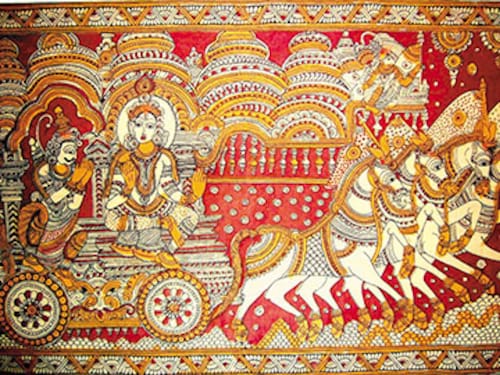

Long before there was the modern and contemporary, there was the indigenous—and what an interesting range and genealogy it enjoyed. Tribal and folk art have the smell and feel of the land in a way that is different from any culture’s classical high art, which, in India, is represented by the Ajanta frescos and classical miniatures. As new-age art experiments drown out all that has gone before, here is a brief anthology of a few traditions that have survived over the ages and held their own in an art-conscious society.
View slideshow: Discover the beauty of India's native art
The cloth canvas
------------------------
Kalamkari, Telangana/Andhra
We are so used to wearing garments made from the handblock-printed Kalamkari technique that we rarely stop to consider that, as painted cloths or curtains, these are one of the finest examples of traditional art in India. Samples of rare Kalamkari fabrics and hangings from the 15th and 16th centuries are documented in museums and collections in Europe, and fragments from an earlier era have been found in China, presumably used as wall hangings. While what we wear is usually from the Machilipatnam region and concerns itself with handblock prints, what we consider art owes itself to the Srikalahasti style of drawing freehand using a pen (‘kalam’) to create images of gods, humans and, occasionally, delightful diversions such as Europeans in top hats! Before being exported to the West, their use was restricted to scrolls, temple cloths and chariot curtains. In this, they are akin to Phad and Pichwai from Rajasthan and had a similar social and religious purpose. Since these are largely handblock-printed, the fewer hand-drawn attempts are artistically unique and rare. In terms of story-telling, the Kalamkari painted cloth tries to provide a religious or historical narrative, often in the form of panels, with or without a dominant central figure. The use of black outlines, blue and ochre, and a coloured backdrop, with voluptuous figuration, adds to its distinctiveness.
Robust exuberance
------------------------------
Patachitra, Odisha 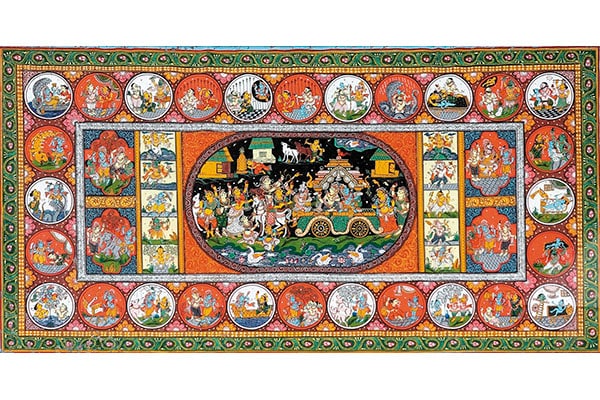 With Raghurajpur as its centre, and the region around Puri popular for these scroll paintings, initially made on palm leaf or cloth, and now on paper, the Patachitra tradition is inspired by the Jagannath and Vaishnava cult and centres around the worship of these deities at their temples. Narratives from anecdotes in their lives as well as the 10 incarnations of Vishnu are illustrated in a lively manner, using strong outlines in lamp black reminiscent of South-East Asian decorative traditions. The stylised paintings are made by a community of chitrakars and contain mineral colours and glue that are fastened with the use of lacquer. The artists draw directly on these scrolls and fill in the colours, using trees and borders to render them more attractive, while the subject is usually heroic and robust. An interesting diversion is an erotic tradition in the same style that is used in the making of ganjifas or playing cards and are thought to be a pillow book that serves as a manual for lovers.
With Raghurajpur as its centre, and the region around Puri popular for these scroll paintings, initially made on palm leaf or cloth, and now on paper, the Patachitra tradition is inspired by the Jagannath and Vaishnava cult and centres around the worship of these deities at their temples. Narratives from anecdotes in their lives as well as the 10 incarnations of Vishnu are illustrated in a lively manner, using strong outlines in lamp black reminiscent of South-East Asian decorative traditions. The stylised paintings are made by a community of chitrakars and contain mineral colours and glue that are fastened with the use of lacquer. The artists draw directly on these scrolls and fill in the colours, using trees and borders to render them more attractive, while the subject is usually heroic and robust. An interesting diversion is an erotic tradition in the same style that is used in the making of ganjifas or playing cards and are thought to be a pillow book that serves as a manual for lovers.
View slideshow: Discover the beauty of India's native artCut to order
-----------------
Sanjhi, Mathura 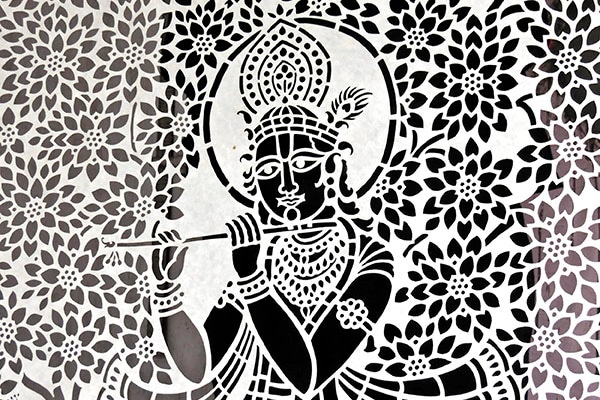 Though it has been criticised for being static—Sanjhi is, after all, a paper cutting technique—in the hands of a master wielder of its formidable and specially constructed scissors, it can produce works of great beauty. Once extensively practiced, and used as stencils for rangolis or applique patterns on the floor with coloured powders, Sanjhi is now restricted almost exclusively to Mathura, Krishna’s birthplace. Although an art by itself, designers have used it as a ‘craft’ for lampshades, utility boxes and the like. Centred around the lore of Radha and Krishna, it can range from their images and motifs to more complicated anecdotes from their mythological narratives. At its most complex, artists can recreate extremely intricate voids (the cut-out spaces) and solids, as fine as filigree. These artists rarely work in ateliers and are likely to be self-driven, much like Radha, who is believed to be the first Sanjhi artist. Sanjhi papercuts are placed against a solid background to highlight the fine tracery of details.
Though it has been criticised for being static—Sanjhi is, after all, a paper cutting technique—in the hands of a master wielder of its formidable and specially constructed scissors, it can produce works of great beauty. Once extensively practiced, and used as stencils for rangolis or applique patterns on the floor with coloured powders, Sanjhi is now restricted almost exclusively to Mathura, Krishna’s birthplace. Although an art by itself, designers have used it as a ‘craft’ for lampshades, utility boxes and the like. Centred around the lore of Radha and Krishna, it can range from their images and motifs to more complicated anecdotes from their mythological narratives. At its most complex, artists can recreate extremely intricate voids (the cut-out spaces) and solids, as fine as filigree. These artists rarely work in ateliers and are likely to be self-driven, much like Radha, who is believed to be the first Sanjhi artist. Sanjhi papercuts are placed against a solid background to highlight the fine tracery of details.
View slideshow: Discover the beauty of India's native art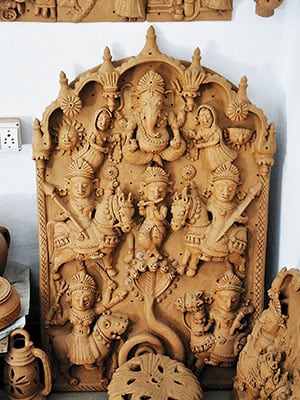 Moulded by hand
Moulded by hand
------------------------
Molela terracotta, Rajasthan
Molela village in the Rajsamand district of Rajasthan has gained the distinction of making flat surface terracotta tablets embossed with images of tribal gods and goddesses that make their way across the country to be sold in urban markets. Though it appears like a simple craft, making these terracotta plaques, from clay found on the banks of the Banas river, can sometimes be a gargantuan task, consisting of complex, relief-like murals. Actually, the art is fairly simple and consists of coils of clay used to create simple representations of the snake god (Nagaraja) and the god of gods (Devnarayan) intended as votive objects for pilgrims from Madhya Pradesh. Over time, the artists — to call them potters would be heresy — began to create images of other deities as well as social and historical subjects, as well as secular images to appeal to a wider audience. The terracotta plaques are first dried in the sun, then fired in an open kiln with shards of pottery, cow dung and wood to maintain a constant temperature. These plaques are sometimes planned by these artists to create wall murals that fit in together like a giant jigsaw.Ode to Krishna
---------------------
Pichwai, Rajasthan
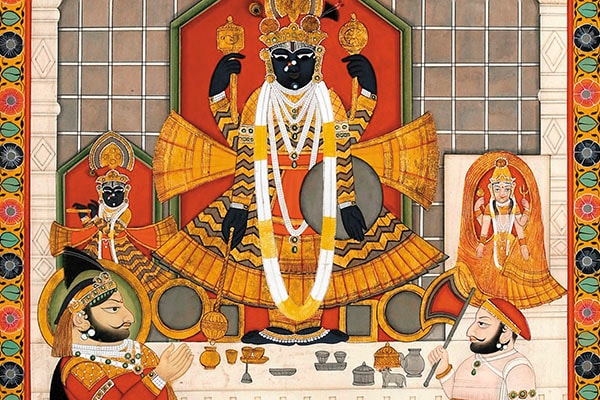 Pichwai paintings are made on cloth and were traditionally created as curtains or backdrops for the idol of Krishna in the village of Nathdwara, a major pilgrimage centre outside Udaipur. Jhankis, or glimpses of Krishna, are provided at different times of the day, with a change of attire for the idol and the curtains this was the impetus for artists to settle here, making classical paintings around the theme of Krishna and his cows. Over time, and with interventions from designers, a popular style has emerged of paintings on cloth with stone colours, and on paper, that appeal to a cross section of society. While most follow the covenants from which it emerged, others are excitingly contemporary, rendered almost as though stenciled and consisting of only rows of cows, or of lotuses, creating a dynamic relationship between the artist and his subject. Others are bejewelled and embellished, headed for prayer rooms rather than living spaces, part of an art tradition that bridges the ritual with the aesthetic. The best of both command great values, though the bulk remains affordable.
Pichwai paintings are made on cloth and were traditionally created as curtains or backdrops for the idol of Krishna in the village of Nathdwara, a major pilgrimage centre outside Udaipur. Jhankis, or glimpses of Krishna, are provided at different times of the day, with a change of attire for the idol and the curtains this was the impetus for artists to settle here, making classical paintings around the theme of Krishna and his cows. Over time, and with interventions from designers, a popular style has emerged of paintings on cloth with stone colours, and on paper, that appeal to a cross section of society. While most follow the covenants from which it emerged, others are excitingly contemporary, rendered almost as though stenciled and consisting of only rows of cows, or of lotuses, creating a dynamic relationship between the artist and his subject. Others are bejewelled and embellished, headed for prayer rooms rather than living spaces, part of an art tradition that bridges the ritual with the aesthetic. The best of both command great values, though the bulk remains affordable.
View slideshow: Discover the beauty of India's native art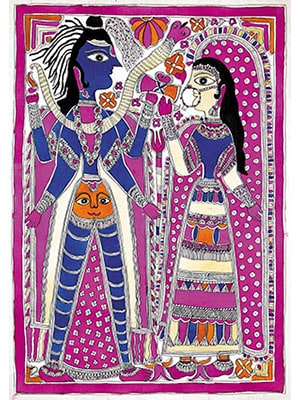 A celebration of life
A celebration of life
-------------------
Madhubani, Bihar
Probably India’s most well-known folk art form, Madhubani — or, correctly, Mithila — paintings date back to the celebration of Sita’s wedding with Rama, but have been likened to works by Miro and Picasso by some critics. Practiced by women artists, its origins lie in the nuptial chamber that would be decorated by them with paintings on walls plastered with a mix of mud and cow dung to denote fertility symbols and the passage of life. Over time, the practice spread across the region, and was used to decorate the walls of village homes, though within strict caste coherence. Its migration to paper, to appeal to urban tastes, has not been at the cost of the sense of joie de vivre, which is a natural expression of these paintings, and has been more democratic, with artists expressing their creativity and even commenting on current issues. Using organic dyes in a rich arrangement of colours, several award-winning artists have become household names and have been felicitated globally—among them Sita Devi, Ganga Devi, Jagdamba Devi, Mahasundari Devi and Bua Devi.Once upon a time
-------------------------
Phad, Rajasthan
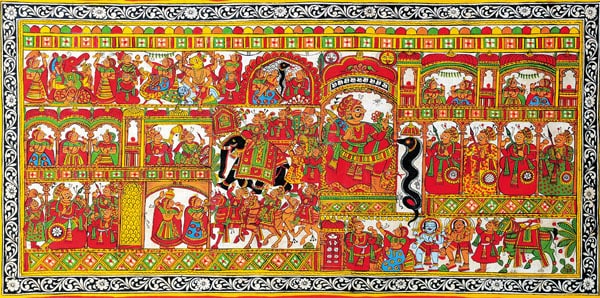 There was a time when the Bhopas, or bards, of the Nayaka community in Rajasthan would travel across the state to entertain villagers. Their tools included a painted scroll and a lantern. The scroll—or phad—contained vignettes of the life of Pabuji, or of Dev Narayan, folk heroes enshrined in the paintings, and hence in collective memory, as deities, thus making these enactments sacred as well as entertaining. Come evening and the Bhopas would stretch out a phad, like a theatre backdrop, and holding a lantern to light up one part of it, sing and dance the hero’s exploits. Also called mobile temples, these scrolls are painted by Chipas, a caste that traditionally prints on cloth, using gum and flour before being rubbed with a stone to fasten the colours and add a sheen. What these textile painters looked for was consistency, not creativity. These paintings are gaining in popularity although their subjects remain traditional.
There was a time when the Bhopas, or bards, of the Nayaka community in Rajasthan would travel across the state to entertain villagers. Their tools included a painted scroll and a lantern. The scroll—or phad—contained vignettes of the life of Pabuji, or of Dev Narayan, folk heroes enshrined in the paintings, and hence in collective memory, as deities, thus making these enactments sacred as well as entertaining. Come evening and the Bhopas would stretch out a phad, like a theatre backdrop, and holding a lantern to light up one part of it, sing and dance the hero’s exploits. Also called mobile temples, these scrolls are painted by Chipas, a caste that traditionally prints on cloth, using gum and flour before being rubbed with a stone to fasten the colours and add a sheen. What these textile painters looked for was consistency, not creativity. These paintings are gaining in popularity although their subjects remain traditional. 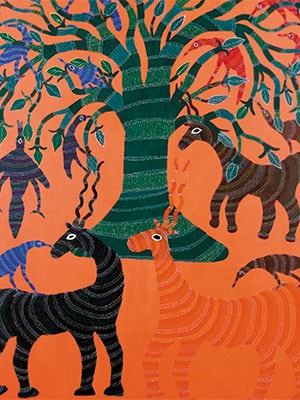 The heartbeat of tradition
The heartbeat of tradition
---------------------
Gond, Central India
The tribal Gond community spreads across Madhya Pradesh and parts of Chhattisgarh, Odisha, Maharashtra, Telangana, Andhra Pradesh and Uttar Pradesh. They are known as keepers of genealogies and bardic traditions. Their lost-wax sculpture techniques are well known, but over the last decades they gained prominence as painters using the pointillist method to make large canvases. According to their belief, a good image begets luck, and so they fill their paintings with forest scenes and deities, though in recent years—with their art becoming globally popular—a more nuanced and contemporary language is emerging. Gond artists now paint using acrylic on paper as well as canvas, with works occasionally showing up at art auctions. Its most important proponent was Jangarh Singh Shyam who, on a cultural exchange to Tokyo, committed suicide. His wife Nankusia, and children, Mayank and Japani, are now keeping the banner flying. 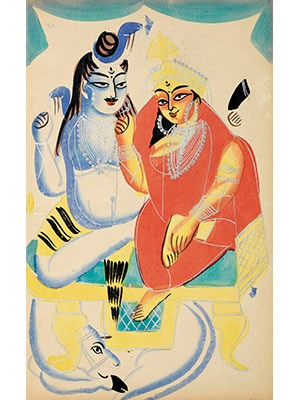 A catalyst for modernism
A catalyst for modernism
--------------------
Kalighat Pat, Bengal
What began literally as a tradition of souvenirs for pilgrims and visitors at the Kali temple in Kolkata is now seen as one of the most important movements of art that has inspired generations of artists in West Bengal with its strong outlines and slight hint of shading. The Kalighat patuas, or artists, combined the local indigenous tradition with what they saw as Western intervention, to result in a style that marked India’s earliest shift towards modernism. In part, this also derived from the subject matter which began with images of Kali, Durga, other popular Indian deities and episodes from the Ramayana, and soon moved to embrace such delightful incidents as the Tarakeshwari scandal about the murder of a married woman having an affair with a priest, or amorous and everyday scenes from the life of the city’s emerging elite, referred to as Babu and Bibi. Western collectors saw these as a means to record Hindu divinity and often carried them back home as postcards of the city. While a watered down, repetitive version of Kalighat keeps emerging from Bengal, the best works from a century ago, painted by the Ghosh brothers, are now highly prized and as expensive as any other work by well-known artists of the time. 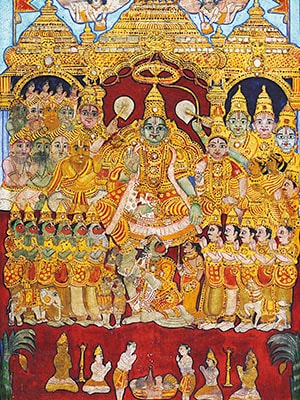 Gilded treasure
Gilded treasure
----------------------
Tanjore, Tamil Nadu
Tanjore — now Thanjavur — paintings originated in the 17th century Maratha court and are an amalgamation of Deccani, Maratha and Company styles, though their essence is uniquely South Indian. The secular paintings of historical subjects were intended as embellishments in the palaces of court officials, while the religious images of gods and goddesses had a devotional purpose. Such paintings seem to consist of cherubic gods with rosebud lips rendered in flat colours on canvas that is placed on wood with the help of gum. French chalk or powdered limestone with a binding medium forms the base on which extensive gold foil and gesso work embellishes these paintings, turning them into gilded objects of veneration. Often, the clothes and jewellery of the figures, placed in the centre of the painting, as well as some architectural features, are further decorated with semi-precious and precious gemstones. Now popular across the country, an interesting alternative to this style are the Thanjavur glass paintings in which the reverse surface of sheets of mica (rarely glass) has strips of beaten metal interspersed in between the painted surfaces, thereby recreating the Tanjore style in a more appealing format.
First Published: Apr 16, 2016, 07:53
Subscribe Now(This story appears in the Nov 05, 2010 issue of Forbes India. To visit our Archives, Click here.)